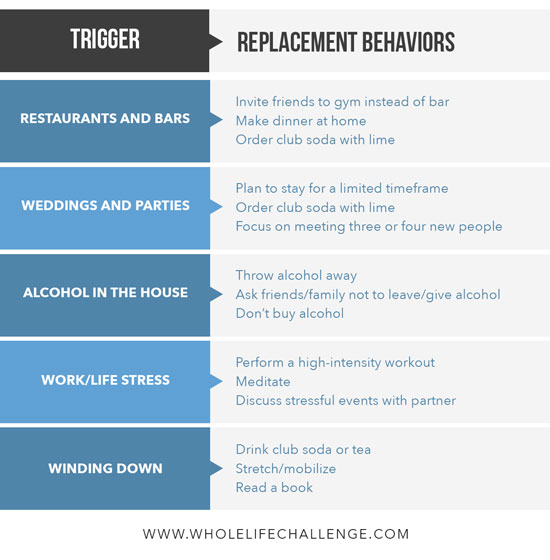 Reading Time: 5 minutes
Reading Time: 5 minutesWillpower is a fragile thing. Subjected to stress, sleep deprivation, or simple visual triggers, it disappears, our resolutions evaporating in the face of reality.
You’ve likely experienced this (along with a subsequent dose of guilt) — a brief argument with your partner turns into a consolation drink, a late night slice of pizza, and a three-hour Netflix binge — all things that felt necessary in the moment, but all working directly against your health and fitness goals.
It doesn’t have to be this way.
You can enhance your willpower and with it, your ability to fight temptation. To do so, you’ll look outside yourself, focusing not on your mental state, but on controlling your environment and your reaction to temptation, setting up a system that takes full advantage of the psychology of willpower.
Read on for your four-step guide on how to enhance your willpower.
Step 1: State Your Willpower Goal in Writing
The first step to maintaining willpower in the face of temptation is to clearly define what you’re trying to achieve. Too often, our goals are poorly defined and therefore unachievable. To begin, grab a pen and a piece of paper.
- First, write down your general goal. As an example, if I’m attempting to quit drinking alcohol, I’ll write exactly that at the top of the page: “Quit drinking.”
- Next, write down exactly what this means. In my case, “No beer, bourbon, wine, or booze of any kind at any time, regardless of circumstance.”
- Finally, ascribe a timeframe to the goal. Keep in mind that taking small steps will aid your ability to maintain progress, so write something like: “I’ll begin by not drinking any alcohol at all for thirty days.”
Now, we’ve defined exactly what “maintaining willpower” means, added a timeframe to the effort, and written it down, giving tangible form to what was formerly an abstract goal. The act of writing makes the goal “real,” and therefore something you’re more likely to accomplish.
Step 2: Recognize Your Triggers
Next, recognize (and record) the circumstances that erode your willpower. These may include lack of sleep, conflict, stress, or simple physical temptation (such as the presence of alcohol, sugar, or electronics). When your triggers are present, you’re more likely to give in and subvert your plan.
- On your goal sheet, write down each trigger. In the case of my alcohol goal, it might look like this: “Triggers for alcohol consumption: going to restaurants and bars, weddings and parties, having alcohol in the house, work/life stress, winding down in the evening.”
By acknowledging and writing down these triggers, I become more aware of their presence in my life. Combined with step three, this awareness enhances my ability to fight temptation in the moments when I’ll be most likely to trip up.
Step 3: Create Replacement Behaviors
For each trigger, list multiple behaviors that could replace the non-desired behavior. In my example, I would avoid drinking in the presence of my triggers by engaging in the following replacement behaviors instead:
Having multiple replacement behaviors for each trigger is important. It enables you to select the replacement that is most likely to work in any given circumstance. For instance, I may not be able to leave my sibling’s wedding early to avoid drinking, but I can order club soda and focus on meeting and connecting with new people.
There is a psychological power in the replacement behavior. Instead of focusing on what you’re not going to do, you can focus on what you are going to do.This will give you an immediate sense of control as well as a different set of emotions around willpower — creating pride and empowerment rather than guilt and avoidance.
Step 4: Recognize Success
Each time you engage in a replacement behavior, give yourself credit, recording your success on your paper with a hash mark or an “x.”
This act is instrumental in reinforcing your willpower. It creates a positive feedback loop — seeing your small successes in writing will encourage you to strive for additional successes, and your willpower in the moment will become willpower for the day, the week, the month, and the year.
Additionally, recording your successes gives you something to do when you get a win (rather than something not to do, as is the case with most behavior avoidance scenarios). As was the case with replacement behaviors, action becomes more satisfying than inaction, further reinforcing progress.
Putting It All Together to Build Willpower
Willpower can be a fragile thing — but it doesn’t have to be. Using this system will enhance and augment your mental capacities, making your resolve more durable while strengthening your ability to accomplish your goals.
The four-step system:
- Define your willpower goals
- Recognize and record your triggers
- Create replacement behaviors
- Recognize success
The system works equally as well whether you’re trying to stop a behavior or create a new one, such as an exercise habit. All you need is any piece of paper, a pen, and a quiet moment.
Take that moment now — grab a piece of paper and give it a shot. Outline your goal, your triggers, and your replacement behaviors. Put the paper in your pocket, and be ready to record your first success. With practice, you’ll find your willpower growing and your goals accomplished, moment by moment, day by day.









